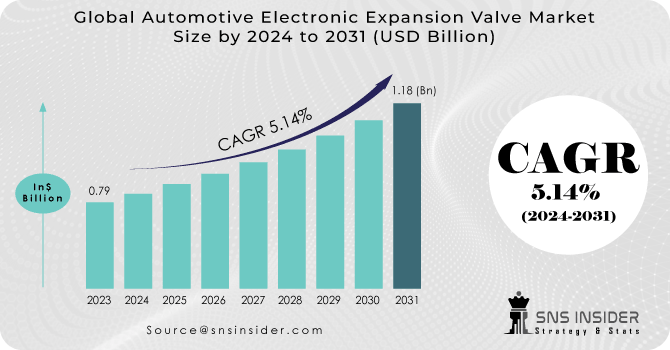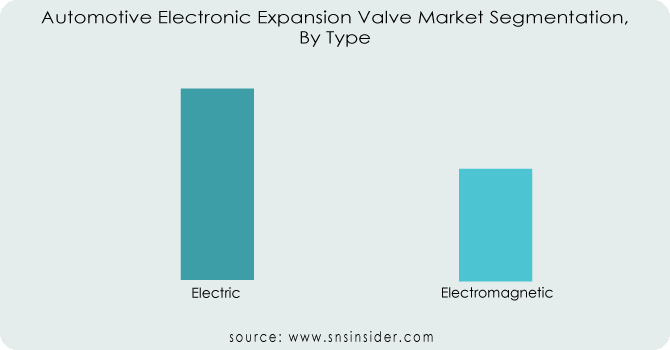Automotive Electronic Expansion Valve Market Size

Get More Information on Automotive Electronic Expansion Valve Market - Request Sample Report
The Automotive Electronic Expansion Valve Market size was valued at USD 0.79 billion in 2023 and is expected to reach USD 1.18 billion by 2031 and grow at a CAGR of 5.14% over the forecast period 2024-2031.
In a car's air conditioning system, a key component for maintaining a comfortable and cool cabin is the Automotive Electronic Expansion Valve (EXV). This valve acts as a regulator, precisely controlling the amount of refrigerant that enters the evaporator. Unlike traditional valves, the EXV leverages electronic controls to adjust refrigerant flow based on real-time data like temperature and pressure within the system. This precise control ensures optimal cooling efficiency. By carefully managing the refrigerant, the EXV contributes to several benefits. It allows the air conditioning system to maintain the desired cabin temperature efficiently, reducing energy consumption and ultimately improving a vehicle's fuel economy. Additionally, the EXV's precise operation translates to a more comfortable driving experience for passengers by ensuring consistent and effective cooling. The applications for Automotive Electronic Expansion Valves are primarily within the automotive industry's air conditioning systems. They are prevalent in passenger cars, commercial vehicles, and any other automotive application where maintaining a controlled cabin climate is crucial. By precisely regulating refrigerant flow through the evaporator, EXVs play a vital role in achieving optimal cooling performance, improved fuel efficiency, and enhanced passenger comfort.
| Report Attributes | Details |
|---|---|
| Market Segmentation | • by Type (Electromagnetic, Electric) • by Application (Passenger Cars, Commercial Vehicles) |
| Regional Analysis | North America (US, Canada, Mexico), Europe (Eastern Europe [Poland, Romania, Hungary, Turkey, Rest of Eastern Europe] Western Europe] Germany, France, UK, Italy, Spain, Netherlands, Switzerland, Austria, Rest of Western Europe]), Asia Pacific (China, India, Japan, South Korea, Vietnam, Singapore, Australia, Rest of Asia Pacific), Middle East & Africa (Middle East [UAE, Egypt, Saudi Arabia, Qatar, Rest of Middle East], Africa [Nigeria, South Africa, Rest of Africa], Latin America (Brazil, Argentina, Colombia, Rest of Latin America) |
| Company Profiles | Fujikoki, CAREL INDUSTRIES, SANHUA, Saginomiya, Emerson, DunAn, Castel, VOLGA, Parker, Emerson, and Danfoss Group |
MARKET DYNAMICS:
KEY DRIVERS:
-
Electronic Expansion Valves are getting smarter with better sensors, algorithms, and materials for precise car cooling control.
Car air conditioning and temperature control systems are getting a boost due to evolving Electronic Expansion Valves (EEVs). These valves, crucial for regulating refrigerant flow, are becoming more sophisticated due to advancements in technology. Better sensors provide real-time data on operating conditions, allowing the valve to precisely control refrigerant for optimal cooling. The smarter control algorithms, incorporating machine learning, enable EEVs to anticipate and adjust to changing needs. Furthermore, innovative materials are enhancing the durability and reliability of these valves. This progress paves the way for integrating EEVs into smart car systems, creating a more efficient and comfortable driving experience.
-
Electric Cars Drive Demand for Smarter Cooling Systems.
RESTRAINTS:
-
High initial cost of electronic expansion valves compared to traditional mechanical ones could hinder adoption.
-
Dependence on complex control systems and sensors might increase maintenance problems for some users.
OPPORTUNITIES:
-
The Automotive Electronic Expansion Valve market can thrive by catering to the growing demand for energy-efficient vehicles due to stricter emission regulations.
-
Rising consumer preference for in-cabin comfort can be addressed by EEVs that optimize air conditioning performance.
CHALLENGES:
-
Electrification challenges EEV manufacturers with unique thermal demands for battery systems and high-power electronics.
Unlike engines with consistent heat output, EVs require precise temperature control for both passenger comfort via air conditioning and optimal battery function. The high-powered electrical systems in EVs demand robust EEV technology that can handle these unique thermal characteristics and ensure durability. The rapid advancements in EV technology necessitate agility from EEV manufacturers to adapt their products to the ever-evolving needs of the electrified automotive landscape.
IMPACT OF RUSSIA-UKRAINE WAR
The Russia-Ukraine war has disrupted the supply chains of the Automotive Electronic Expansion Valve Market as both Russia and Ukraine are key suppliers of raw materials and components crucial for EEV production. This can lead to shortages and price hikes for EEVs. The war decreases the overall economic activity, potentially leading to decreased consumer demand for new vehicles, including those equipped with EEV technology. The sanctions imposed on Russia can restrict access to their EEV manufacturers, impacting market competition and potentially leading to production slowdowns. The war might indirectly benefit the market by accelerating the shift towards electric vehicles due to rising fuel prices. As electric vehicles require robust thermal management systems that utilize EEVs, this could create a long-term growth opportunity for the market.
IMPACT OF ECONOMIC SLOWDOWN
An economic slowdown can disrupt the Automotive Electronic Expansion Valve (EEV) market by limiting consumer budgets during downturns lead to a potential 10-20% decline in new car sales, especially impacting EEVs which are often found in feature-rich newer vehicles. This decrease in demand is further amplified by automakers who react to lower consumer confidence by delaying production of 5-15% or reducing overall vehicle output. The cost-conscious consumers prioritize affordability over features during slowdowns, potentially leading to a 5-10% decline in EEV sales even within existing car models as they shift towards simpler vehicles. The combined effect of these factors could result in a contraction of the EEV market by 15-30% depending on the severity and duration of the economic slowdown. This causes to the potential production slowdowns, price wars among EEV manufacturers to stay competitive, and even job losses within the EEV industry.
KEY MARKET SEGMENTS:
By Type:
-
Electric
-
Electromagnetic
The Electric EEVs is the dominating sub-segment in the Automotive Electronic Expansion Valve Market by type holding around 60-70% of market share due to their superior control, accuracy and energy efficiency compared to electromagnetic EEVs. Electric expansion valves utilize the electric motor to regulate the flow of refrigerant, leading to optimal cabin comfort and fuel economy. This aligns well with growing demand for eco-friendly vehicles.

Get Customized Report as per your Business Requirement - Request For Customized Report
By Application:
-
Commercial Vehicles
-
Passenger Cars
The passenger car is the dominating sub-segment in the Automotive Electronic Expansion Valve Market by application holding around 55-65% of market share. This can be attributed to the rising demand for advanced features and in-cabin comfort in personal vehicles. EEVs contribute significantly to maintaining optimal cabin temperature and improving fuel efficiency, which are key priorities for passenger car buyers.
REGIONAL ANALYSES
The Asia Pacific is the dominating region in the Automotive Electronic Expansion Valve Market holding around 40-45% of market share. This dominance stems from their growing car production which fuels demand for EEVs in new vehicles. The government initiatives promoting electric vehicles indirectly benefit the EEV market as electric cars rely heavily on this technology. Asia's strong EEV component supply chain also contributes to potentially lower production costs, making EEVs more accessible. Europe is the second highest region with 30-35% of market share driven by their stringent emission regulations that push carmakers towards fuel-efficient technologies like EEVs. European consumers' preference for advanced features like automatic climate control, which necessitates EEVs, further strengthens their market position.

REGIONAL COVERAGE:
North America
-
US
-
Canada
-
Mexico
Europe
-
Eastern Europe
-
Poland
-
Romania
-
Hungary
-
Turkey
-
Rest of Eastern Europe
-
-
Western Europe
-
Germany
-
France
-
UK
-
Italy
-
Spain
-
Netherlands
-
Switzerland
-
Austria
-
Rest of Western Europe
-
Asia Pacific
-
China
-
India
-
Japan
-
South Korea
-
Vietnam
-
Singapore
-
Australia
-
Rest of Asia Pacific
Middle East & Africa
-
Middle East
-
UAE
-
Egypt
-
Saudi Arabia
-
Qatar
-
Rest of the Middle East
-
-
Africa
-
Nigeria
-
South Africa
-
Rest of Africa
-
Latin America
- Brazil
- Argentina
- Colombia
- Rest of Latin America
KEY PLAYERS
The major key players are Fujikoki, CAREL INDUSTRIES, SANHUA, Saginomiya, Emerson, DunAn, Castel, VOLGA, Parker, Emerson, Danfoss Group and other key players.
Saginomiya-Company Financial Analysis

RECENT DEVELOPMENTS:
-
In Oct 2020: Saginomiya's innovation was recognized at CEATEC 2020. Their participation in a NEDO project resulted in a Grand Prix win for the most cutting-edge technology exhibited. This project involved a vibrational energy harvester.
| Report Attributes | Details |
|---|---|
| Market Size in 2023 | US$ 0.79 Billion |
| Market Size by 2031 | US$ 1.18 Billion |
| CAGR | CAGR of 5.14% From 2024 to 2031 |
| Base Year | 2023 |
| Forecast Period | 2024-2031 |
| Historical Data | 2020-2022 |
| Report Scope & Coverage | Market Size, Segments Analysis, Competitive Landscape, Regional Analysis, DROC & SWOT Analysis, Forecast Outlook |
| Key Segments | • by Type (Electromagnetic, Electric) • by Application (Passenger Cars, Commercial Vehicles) |
| Regional Analysis/Coverage |
North America (US, Canada, Mexico), Europe (Eastern Europe [Poland, Romania, Hungary, Turkey, Rest of Eastern Europe] Western Europe] Germany, France, UK, Italy, Spain, Netherlands, Switzerland, Austria, Rest of Western Europe]), Asia Pacific (China, India, Japan, South Korea, Vietnam, Singapore, Australia, Rest of Asia Pacific), Middle East & Africa (Middle East [UAE, Egypt, Saudi Arabia, Qatar, Rest of Middle East], Africa [Nigeria, South Africa, Rest of Africa], Latin America (Brazil, Argentina, Colombia Rest of Latin America |
| Company Profiles | Fujikoki, CAREL INDUSTRIES, SANHUA, Saginomiya, Emerson, DunAn, Castel, VOLGA, Parker, Emerson, and Danfoss Group |
| Key Drivers | •The adoption of the vehicle electronic expansion valve is motivated by the need to improve the engine's fuel economy. •The rising preference for freight transportation on roadways is expected to drive sales of HCVs. |
| RESTRAINTS | •The vehicle electronic expansion valve market may be constrained by high initial and maintenance expenses. •The rising usage of electric vehicles around the world is projected to restrain the worldwide market's growth. |

